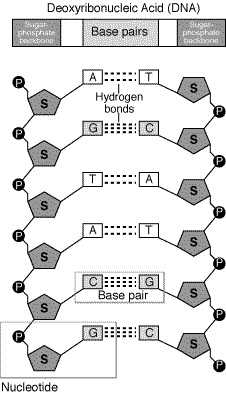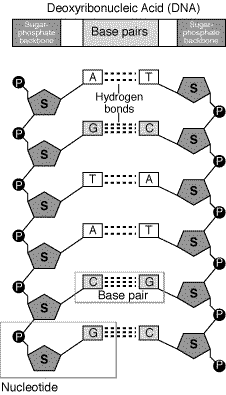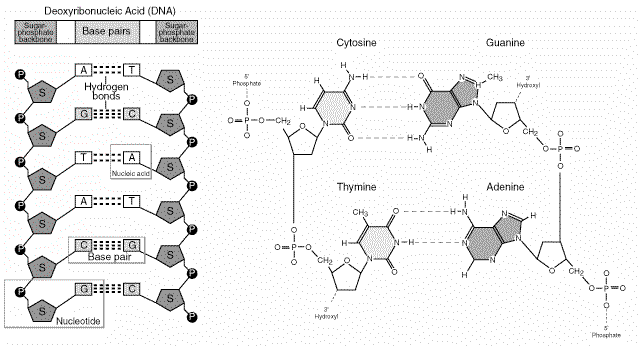The Structure of DNA
MITx Bio (26 May 2015) The Structure of DNA [Video file] retrieved from https://youtu.be/o_-6JXLYS-k
MITx Bio (26 May 2015) The Structure of DNA [Video file] retrieved from https://youtu.be/o_-6JXLYS-k


DNA is a nucleic acid. Nucleic acids are polynucleotides. That means they are made up of chains of many repeating units called nucleotides.
The DNA molecule consists of two polynucleotide chains that spiral around an imaginary axis to form a double helix (spiral). Nucleic acid molecules are incredibly complex. They make up the code that guarantees the accurate ordering of the 20 amino acids in all proteins made by living cells. Surprisingly though there are only a few different nucleotides. Only four different nucleotide units comprise DNA.
The figure to the right is a diagram of a short stretch of a DNA molecule which is unwound and flattened for clarity. The boxed area at the lower left encloses one nucleotide. Each nucleotide is itself make of three subunits:
A five carbon sugar called deoxyribose (Labeled S)
A phosphate group—a phosphorous atom surrounded by four oxygen atoms (Labeled P).
And one of four nitrogen-containing molecules called nucleotide bases. (Labeled A, T, C, or G).

The figure to the right is a diagram of a short stretch of a DNA molecule which is unwound and flattened for clarity. The boxed area at the lower left encloses one nucleotide. Each nucleotide is itself make of three subunits:
A five carbon sugar called deoxyribose (Labeled S)
A phosphate group—a phosphorous atom surrounded by four oxygen atoms (Labeled P).
And one of four nitrogen-containing molecules called nucleotide bases. (Labeled A, T, C, or G).

Alternating sugar and phosphate units form the two sides of a ladder-shaped arrangement with the rungs or steps each formed by a pair of nucleotide bases (bps). The sides of the ladder are held together by weak electrostatic bonds between base pairs called hydrogen bonds (sort of the velcro of the molecular world). The human genome has about 3,000,000,000 bps!
The figure below shows the structural formula of DNA in greater detail. The nitrogen bases shown to the right of the diagram are ring compounds with their carbon and nitrogen atoms arranged in single or double rings. Single ringed bases are called pyrimidines and double ringed bases are called purines. Only certain bases can pair together to form base pairs (bps.) In DNA, Adenine (A) always pairs with thymine (T), and guanine (G) always pairs with cytosine (C).

Notice that in figures 1 and 2, the two strands of a DNA molecule are antiparallel, that is, they run in different directions. The side of the chain on the left begins with a free phosphate group at the top and ends with a sugar molecule at the bottom. In contrast, the complementary chain on the right begins at the top with a sugar molecule and ends at the bottom with a phosphate group.
The phosphate end of the DNA molecule is called the 5' end (pronounced five prime end.)
The sugar end is called the 3' end (3 prime end.)
Happily, it is not necessary to hold the details of DNA structure in your mind at all times! As the sugar and phosphate sides of the molecule are constant, they are frequently represented by parallel lines. Even better, each of the nitrogen bases is conveniently represented by the first letter of its name. These conventions allow the simplified representation of the molecule shown below.

Or, even easier, a section of a DNA molecule is often abbreviated to show the bases of just one strand:
5' A T G G C T A C 3'
Knowing the base pairing convention of A always pairing with T and G always pairing with C makes the complementary strand of the molecule understood. It is this feature of complementary base pairing that insures an exact duplicate of each DNA molecule will be passed to its daughter cells when a cell divides.
Determining the order of the bases in a DNA chain is the goal of DNA Sequencing. Determining the order of the bases in the entire Human genome (the DNA in all human chromosomes) is the goal of the Human Genome Project. For more information about the many issues addressed by the Human Genome Project, see Human Genome Project Information.
Or, even easier, a section of a DNA molecule is often abbreviated to show the bases of just one strand:
5' A T G G C T A C 3'
Knowing the base pairing convention of A always pairing with T and G always pairing with C makes the complementary strand of the molecule understood. It is this feature of complementary base pairing that insures an exact duplicate of each DNA molecule will be passed to its daughter cells when a cell divides.
Determining the order of the bases in a DNA chain is the goal of DNA Sequencing. Determining the order of the bases in the entire Human genome (the DNA in all human chromosomes) is the goal of the Human Genome Project. For more information about the many issues addressed by the Human Genome Project, see Human Genome Project Information.
Some figures on this page were adapted in 2002 from the website of the Office of Science Education and Outreach of the National Human Genome Research Institute: http://www.nhgri.nih.gov/DIR/VIP/Glossary/Illustration/protein.html